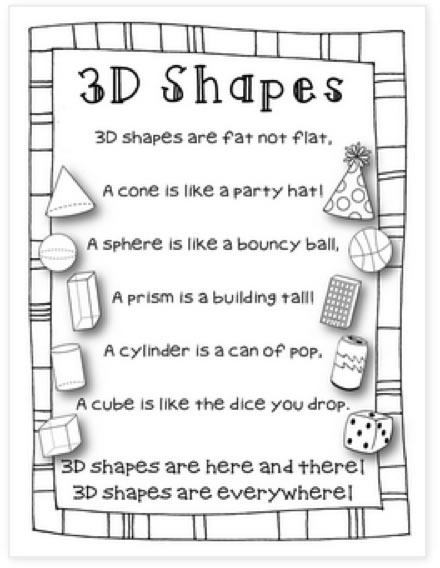Shape of Things
In this lesson, children will learn to identify the various attributes of 3-D shapes (cube, cone, sphere, cylinder, pyramid, prism) through games and Play-doh construction.
Lesson for:
Toddlers/Preschoolers
(See Step 5: Adapt lesson for toddlers or preschoolers.)
Content Area:
Geometry
Learning Goals:
This lesson will help toddlers and preschoolers meet the following educational standards:
- Analyze characteristics and properties of two- and three-dimensional geometric shapes and develop mathematical arguments about geometric relationships
- Use visualization, spatial reasoning and geometric modeling to solve problems
Learning Targets:
After this lesson, toddlers and preschoolers should be more proficient at:
- Recognizing, naming, building, drawing, comparing and sorting two- and three-dimensional shapes
- Describing attributes and parts of two- and three-dimensional shapes
- Investigating and predicting the results of putting together and taking apart two- and three-dimensional shapes
- Creating mental images of geometric shapes, using spatial memory and spatial visualization
- Recognizing and representing shapes from different perspectives
- Recognizing geometric shapes and structures in the environment and specifying their location

Shape of Things
Lesson plan for toddlers/preschoolers
Step 1: Gather materials.
- Play-Doh

- Poster to put up in the classroom and go over with the children
- Objects that resemble 3-D objects or are 3-D objects
- Chart paper divided up into the different shapes
- Music
Note: Small parts pose a choking hazard and are not appropriate for children age five or under. Be sure to choose lesson materials that meet safety requirements.
Step 2: Introduce activity.
- Introduce all of the shapes to the children. Use the poster to help you introduce each of the shapes.
- Ask the children to describe the characteristics of each of the shapes. Write down what they say on the chart paper. Point out the length, width and height of each shape. Be sure to point out the characteristics of the 3-D shapes that make them different from the 2-D shapes.
Step 3: Engage children in lesson activities.
- Introduce the game of “Hot Shape” (played like “Hot Potato”). Have the children gather in a circle and pass one of the shapes from one child to the next while the music plays. The player who is holding the “hot shape” when the music stops has to identify one characteristic of the shape. The game continues until all of the characteristics of all six shapes have been named. The game can also be played without music and with a designated leader who shouts out “shape!” The child holding the shape when the leader shouts will then name a characteristic of the shape.
- After playing the game, give the children some Play-Doh to construct the different 3-D shapes.
Additional Extensions
- Have the children close their eyes while playing “Hot Shape.” When the music stops, the children will use their sense of touch to figure out the shape. If they are having difficulty, allow the other children in the circle to give them hints.
Step 4: Vocabulary.
- 3-dimensional: A shape having three dimensions (length, width and height)
- Cone: A solid shape with a circular base and a curved surface that tapers to a point (e.g.,”A cone is like a party hat.”)
- Sphere: A ball. A three-dimensional solid that is perfectly round (e.g.,”A sphere is like a bouncy ball.”)
- Prism: A solid three-dimensional shape with two identical bases (e.g.,”A prism is a tall building.”)
- Cylinder: A solid shape with one curved surface and two identical bases (e.g.,”A can of pop is a cylinder.”)
- Cube: A solid shape that has six square faces all equal in size, eight vertices and 12 equal edges (e.g.,”A cube is like the dice you drop.”)
Step 5: Adapt lesson for toddlers or preschoolers.
Adapt Lesson for Toddlers
Toddlers may:
- Not yet be ready to name the characteristics of the different 3-D shapes
Child care providers may:
- Familiarize the children with the 3-D shapes by allowing them to build and engage in free play with the shapes
Adapt Lesson for Preschoolers
Preschoolers may:
- Readily identify the characteristics of the 3-D shapes
- Have a real aptitude for building with the Play-Doh and a solid sense of spatial reasoning
Child care providers may:
- Have the children close their eyes while playing “Hot Shape.” When the music stops, the children will use their sense of touch to figure out the shape. If they are having difficulty, allow the other children in the circle to give them hints.
- Give the children a challenge or a problem to solve (like designing a car of the future) and watch them get creative. Group members can work together to create a sculpture or an imaginary animal. They can also give a small presentation about their construction. Make sure that the children use and combine the 3-D shapes discussed.
Suggested Books
- The Shape of Things by Julie Lacome (New York: Candlewick, 1996)
- 3-D Shapes (My Path to Math) by Marina Cohen (New York: Crabtree Publishing Company, 2010)
Music and Movement
Outdoor Connections
Many additional ideas to extend the study of 3-D shapes
- Take a trip to a grocery store and look for 3-D shapes on the shelves. Packaging for food comes in many different shapes. You are likely to see many cylinders and prisms, but be on the lookout for spheres and cones.
Web Resources
Teaching 3-D Shapes and Songs: Activities and free printables

Comment on this lesson